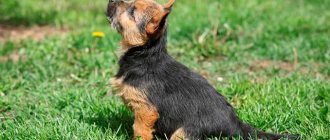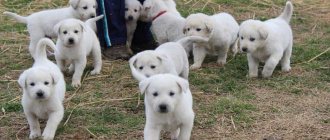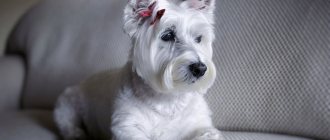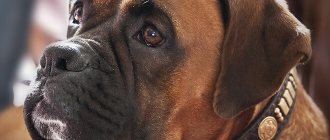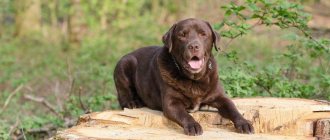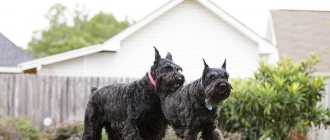The Bloodhound is a large breed of hunting dog, originally bred as a big game hound. It has an excellent sense of smell and is used in hunting and search operations.
In the article we will analyze the pros and cons of bloodhounds, the nature of the hound breed. features of care and maintenance and prices for puppies.
More photos →
| How long do they live? | 10-12 years |
| Weight | males 46 – 54 kg, females 40 – 48 kg |
| Height (height at withers): | males 64 – 72 cm, females 58 – 66 cm |
| Puppy price | 50-90 thousand rubles |
Breed standard
A large dog with heavy bones, the strongest and most massive among hounds is the Bloodhound, photos of which perfectly reflect the features of its appearance. Despite its impressive dimensions, the animal does not look overweight or clumsy. On the contrary, representatives of the breed are extremely noble and majestic.
Bloodhounds that are too large or heavy are rejected because they cannot effectively perform their direct duties.
Official description of the breed (FCI standard No. 84):
| Become | Breed characteristics |
| Head | Large, slightly flattened on the sides, stands out clearly against the general background. When viewed from the side it appears square. The skin on the Bloodhound's head gathers into deep folds that sag and merge with the dewlap. This is the main distinguishing feature of the Saint-Hubert dogs. In males this feature is especially clearly expressed. |
| Muzzle | The length is equal to the distance from the stop to the occipital protuberance. The stop is weakly expressed. |
| Nose | Large, with large nostrils. Saint-Hubert dogs have black or liver colored lobes. The bridge of the nose is flat or slightly convex. |
| Jaws | The Bloodhound's white teeth are hidden behind soft, full lips, with the upper one covering the lower one. A scissor bite is preferred, but a straight bite is also acceptable. |
| Eyes | Medium, slightly elongated. The lower eyelid droops, causing slight redness of the eyeball. The color of the iris is brown in Saint-Hubert dogs of a dark color, amber in lighter colors. The look is attentive and kind. In the photo, the bloodhound looks melancholy and a little sad. |
| Ears | Long, hanging, covered with short fur - soft and velvety. They sit low, turning inward and backward. If you place your ear on your muzzle, it will easily reach the lobe. |
| Neck | Muscular, so long that the Bloodhound can easily reach the ground with its nose. The skin on the throat hangs loosely, forming a forked dewlap. |
| Breast | Wide, the proportion of depth to height at the withers is 1 to 2. |
| Torso | Slightly stretched, rectangular in shape. The ratio of length and height is approximately 10 to 9. The lines of the back and abdomen are almost parallel to each other. |
| Tail | High rise, thick, long. When calm, it takes the form of a saber; when working, the Bloodhound carries it just above its back. The tail should not curl into a ring or bend to the side. |
| Limbs | Powerful but harmonious. Placed in parallel. The paws are small, the toes are tucked, and the pads are hard. |
According to the RKF classification, bloodhounds belong to group 6: “Hounds, bloodhounds and related breeds.”
Bloodhound is a breed of dog with thick, short and rough fur, which perfectly protects the animal from rain and cold. The longest hairs are located on the underside of the tail. The standard allows the following colors:
- plain red;
- black and red;
- liver-red.
A small amount of white hair on the chest, limbs, and tip of the tail of the Saint-Hubert Hound is permitted, but not encouraged.
The Bloodhound dog breed moves slowly, but its step is light, elastic and free. At a trot, the animal sways slightly from side to side. The dog pushes powerfully with his hind limbs and swings his front limbs well. At this pace, Chien de Saint-Hubert can move for a very long time without any signs of fatigue. In general, the hound looks coherent - not a single dog stands out of the overall harmony.
Bloodhounds with physical or behavioral abnormalities, as well as animals that clearly do not meet the standard, are subject to disqualification. Other defects are considered in accordance with their severity, the degree of influence on the working qualities and health of the dog.
Character
The Bloodhound is a kind and peaceful dog. Chien de Saint-Hubert loves his owner very much. Representatives of the breed have a calm, balanced and sociable character. Well-mannered pets never show aggression. They behave with restraint and caution towards strangers.
Difficulties often arise when training these hounds. The animal can be stubborn, so the Bloodhound breed is not suitable for beginners - an experienced dog breeder should be involved in raising the pet. If the owner is unable to control the dog, it is worth seeking help from a professional dog handler.
Representatives of the breed have a sharp mind, but they do not consider it necessary to unquestioningly obey a person. To prevent the Bloodhound from losing interest, the training duration is limited to 15 minutes. It is better to conduct classes several times a day than to overload your pet with long lessons.
Bloodhounds are sensitive to rewards and punishments. If training is associated with positive emotions, hounds will be more willing to follow commands. Pets are raised firmly but affectionately. Physical influence is excluded, otherwise Chien de Saint-Hubert will completely stop obeying.
Origin, history, creation
There is no reliable information about the origin of the breed. It is known that the Bloodhound is one of the ancient dogs. His ancestors helped people about 1000 years ago. The ancestors of the Bloodhound appeared in the Ancient East, from there they came to European countries.
It is generally accepted that the birthplace of the Bloodhound is Belgium. It was the monks of the Ardennes monastery in the Belgian town of Saint-Hubert who put a lot of effort into shaping the breed in the form it appears now. They started breeding these dogs in the 13th century, and by the 17th century the breed had all the modern traits.
Experts believe that the breed was created by crossing Molosser dogs and North American hounds.
Interesting! In Belgium, the Bloodhound is the legendary hound of Saint Hubert. The dog takes center stage at the international hunter festival, which is held annually in early September.
Bloodhound is a dog that has been used since the time of kings to hunt wolves, lynx, and deer. Translated, the word “bloodhound” means “blood dog.” The name reflects the purpose of the breed - to follow the bloody trail of a wounded animal.
Application
Initially, the Bloodhound dog breed was bred to follow the blood trail. The animals have an incredible sense of smell - this quality makes them superior to all other hounds.
Now cops are involved in search operations. Bloodhounds search for missing people and animals, fugitives. Representatives of the breed are very hardy - they work tirelessly for many hours in a row.
The police have a saying that a criminal whose trail is picked up by a bloodhound can be considered already caught. But the pet is a bad guard - he has absolutely no aggression towards humans.
Active people have Bloodhounds as companions. With proper upbringing, they make reliable and loyal friends.
The Ultimate Pathfinders
Blood was developed as an ideal sniffer. He really has no equal.
Everything about this dog is literally designed to take the scent. The capabilities of her sense of smell are simply amazing. By the way, even the characteristic folds on the face and ears serve this purpose: they “sweep” air towards the nose. And the brow ridges and folds above the eyes create a kind of “blinders”. When a dog follows a scent with its head down, at that moment it literally does not see anything around it and can focus solely on the smell.
But advantage can sometimes turn into a disadvantage - especially if we are not talking about a “working” police or search dog, but about a pet kept in an apartment. If the dog “took the scent”, it will not care at all what the owner commands and where he was going to go. As well as the fact that the owner does not need this trace. For this reason, he is not suitable, say, as a guide dog or companion for an elderly person.
Socialization
For centuries, animals worked in fields and forests, so dogs need to be accustomed to life in the city. After the baby gets used to his new family, he is taken outside. The pet is introduced to other people, smells, and introduced into the society of its relatives. Without proper socialization, your pet will grow up fearful and uncontrollable.
Chien de Saint-Hubert enjoys spending time with children. The animal especially likes outdoor games - here the dog can throw out the energy seething in him. But you should not leave a large pet alone with a baby - the hound can accidentally injure him. Also, a Bloodhound dog will not babysit children. She perceives a person as a partner and demands an appropriate attitude towards herself.
The Bloodhound rarely conflicts with its relatives - the hound is full of self-esteem and does not consider it necessary to pay attention to other dogs. The animals also get along easily with other pets. A warm friendship often develops between a cop and a cat.
Training
Raising a bloodhound is not easy, as restless and overly energetic dogs are difficult to train and train.
It is best to hire a special instructor for these purposes, and when choosing an independent option, take your time, do not tease, use game forms and do not use “whip” methods.
How to choose a puppy
Bloodhound puppies are separated from their mother no earlier than 8 weeks. Before buying a dog you should:
- meet parents in person, not from photos;
- inspect the place where the bloodhound babies are kept - the kennel must be clean;
- communicate with the breeder - a conscientious seller will definitely answer your questions, tell you about the characteristics of the breed, the nuances of the character, upbringing and maintenance of hounds.
Bloodhound puppies: photos
The parents of the Bloodhound puppy must have a certificate of absence of congenital pathologies and permission to breed.
It is not recommended to buy animals through advertisements on the Internet from private individuals - there are no guarantees of the health and breed of puppies.
Features of maintenance and care
The Bloodhound is a tireless and active animal. It is highly undesirable to keep a hound in an apartment. The best option for a Saint-Hubert dog is a private house with a spacious plot. But the area must be fenced, otherwise the pet will run away when it smells an interesting smell.
Also, the Bloodhound dog breed is not recommended for people who are often not at home. Animals do not tolerate long separation from their owner. With a lack of attention, pets “play pranks” - they destroy everything that is within their reach.
The Bloodhound has a deep, loud voice. If the dog starts howling alone, the neighbors will definitely come to complain.
Grooming
Animals are brushed once a week, and daily during molting. The skin folds of the Saint-Hubert dog require special care. Bloodhounds need to wipe off their drool regularly; overly squeamish people are advised to look at another breed.
Dirt constantly accumulates on animals' long ears, so they need to be cleaned regularly. Pets’ eyes are also rubbed – failure to maintain hygiene can lead to inflammation and suppuration. If necessary, bloodhounds have their nails trimmed and their dental health is maintained with veterinary paste and dental treats.
Bloodhounds are bathed when they are heavily soiled. After bathing procedures, Saint-Hubert dogs are dried with a hard towel so that the coat shines beautifully. You cannot dry your fur with a hairdryer - hot air has a negative effect on its appearance.
Bloodhounds smell strongly of dog. This is an innate feature that cannot be changed.
Walk
Representatives of the breed need to walk a lot. Preferably in an open area - in a forest or field. Due to lack of exercise, Saint-Hubert dogs begin to play pranks and easily turn the apartment upside down. It’s not enough to just walk through the park with your pet on a leash. Bloodhound is a hound, it must be exhausted and tired. The optimal duration of exercise for these animals is 1.5-2 hours.
The owner needs to be careful while walking. Bloodhounds that are on the trail stop noticing those around them and stop responding to commands. Because of this feature of the breed, animals often get lost and get hit by cars. Dog handlers advise attaching a GPS tracker to your pet to track its location if necessary.
Feeding
Bloodhounds are provided with high-quality and balanced nutrition. A dog's diet may consist of:
- premium and super-premium feed;
- natural food.
In the latter case, the pet menu includes:
- lean meat and offal (beef, lamb, chicken, turkey) – 50%;
- vegetables (carrots, zucchini, pumpkin) – 30%;
- porridge (rice, buckwheat, rolled oats) – 20%.
Additionally, they provide eggs, dairy products, and cheese. Many representatives of the breed do not refuse fruits - apples, pears, peaches. With natural feeding, vitamin and mineral complexes must be introduced into the diet of Saint-Hubert dogs.
Bloodhound puppies are fed 8 times a day, adult animals - twice a day. Food from the human table is not suitable for pets - these hounds have a very sensitive digestive system. Any spicy, salty, processed, fried or pickled food is prohibited.
You should not overfeed the animal - overweight bloodhounds suffer from joint problems.
Bloodhound diet
First of all, we must remember that dogs of this breed are prone to obesity. They should never be overfed to avoid health problems. Excess weight has a particularly bad effect at a young age, when joints are just forming. If in the first months it is acceptable for a kitten to be plump, then by 8 months he should already look muscular, but not fat.
For feeding with ready-made food, choose those “for large breed dogs” that are appropriate for age and lifestyle (for example, for “active dogs” or “indoor dogs”). No one can say which brand is preferable. Or rather, everyone will have their own say. You need to focus only on the opinion of the dog and its condition. The good food is the one that she eats better and the one that has a good effect on her.
A balanced diet with natural nutrition consists of 2/3 meat and offal, 1/3 filler (porridge and vegetables). Meat products can be periodically replaced with fish. Some people recommend only boiled fish and only sea fish, some people think that any fish can be eaten raw. If the fish contains worms, then this is not a reason to refuse it. In any case, the dog is periodically wormed.
It is also believed that poultry meat must be boiled to avoid difficulties with digestion. But again, it’s best to listen to the dog’s opinion. Each organism is individual and what is good for a German is death for a blood. You can give raw bones with leftover meat - this not only entertains the dog, but also helps clean his teeth.
The combination of natural food and prepared feed now seems to no longer cause sharp condemnation. It is only believed that it is better to alternate these types of feeding, and not to give both meat and dry food at the same time. Drying can serve as a source of vitamins and other essential elements that would otherwise have to be given as additional supplements.
Health
The lifespan of Bloodhounds is determined by heredity. Healthy dogs that do not have congenital diseases live about 12 years.
Diseases
The Bloodhound dog breed is prone to eye diseases. Animals often experience:
- macroblepharia;
- turning of the eyelids;
- "cherry eye"
Like all large dogs, Bloodhounds suffer from joint problems. The Saint-Hubert Hound breed is also susceptible to the following diseases:
- epilepsy;
- dermatitis;
- intestinal volvulus;
- eosinophilic gastritis;
- food allergy.
In general, the animals are in good health. With proper care, Bloodhounds rarely have problems. If your pet is feeling unwell, you should show it to a doctor.
Vaccinations
The initial vaccination of Bloodhound puppies is carried out by the breeder. Babies are vaccinated at 2 months of age from:
- plague;
- parvovirus enteritis;
- infectious hepatitis;
- parainfluenza;
- leptospirosis;
- coronavirus;
- trichophytosis.
Every 3 weeks, Saint-Hubert dogs are given a second vaccination. At 6 months, Bloodhounds are given an anti-rabies injection. Adult pets are revaccinated annually and treated for parasites every 3 months.
Mating
Only functionally and clinically healthy animals are allowed for mating. Bloodhounds come into heat at 8-12 months, but Saint-Hubert dogs cannot be crossed that early. Unformed individuals do not bear full-fledged offspring. The optimal age for mating is 2 years and older. About a week before her heat, the bitch's state changes from extremely excited to apathetic.
The partners are first introduced on neutral territory so that they get used to each other, then the bloodhound bitch is brought to the male. Immediately before mating, the pets are walked, but not fed. Mating is best carried out from 11 to 15 days from the start of estrus.
Bloodhounds are usually bred freestyle. For a young bitch, it is recommended to find an experienced dog. If owners are crossing their pets for the first time, they should seek help from a professional breeder who will supervise the process. To increase the likelihood of a favorable outcome, a control mating is carried out after 1-2 days.
Bloodhound pregnancy lasts from 56 to 72 days. If more time has passed, but the bitch has not whelped, it is necessary to take the animal to a veterinarian. a delay indicates the appearance of any pathologies. A healthy Saint-Hubert dog produces on average 3-4 puppies.
Key facts
The country of origin of the breed is Belgium, and the literal translation of the name is “blood dog.” However, not all breeding scientists associate this with the hunting characteristics of the pet. In their opinion, we are talking about the purebred of the individual. Another name for animals included in the characteristics of the Bloodhound breed is the Belgian hound.
Despite their rather impressive size, bloodhounds are not suitable for protection. In addition, they are quite difficult to train, but are considered intellectuals compared to their ancestors. They were terribly stubborn and refused to learn anything.
The dog has a loud, bassy bark that matches its size. Thus, the height of females at the withers reaches 58-64 cm, and the height of males is 62-69 cm. Females weigh about 35-45 kg, the weight of male bloodhounds is about 40-52 kg. The lifespan of Bloodhounds is average and is 10-12 years.
The impressive size does not allow the animal to be owned as a sofa dog. They need space and frequent, long walks with active games and exercise. Therefore, the pet is perfect not only for a hunter, but also for a person leading a healthy lifestyle.
Nurseries
There are not many breeders in Russia who are professionally involved in breeding bloodhounds. The main part is concentrated in the capital region. You can view photos of animals and purchase purebred Saint-Hubert dog puppies in the following kennels in Moscow:
- “Ksenia’s Hope” https://www.bloodhound-nadezhda-ksenii.ru;
- “The Legend of Arden” https://bloodhound-la.narod.ru.
The Bloodhound is a breed with a keen sense of smell and a loving heart. This hound must be led by a strong but fair leader. Long walks and the opportunity to always be close to the owner are a simple recipe for happiness for Saint-Hubert dogs.
